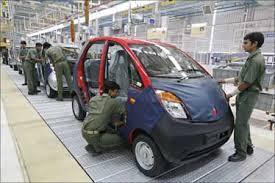In a recent interview, Reserve Bank of India Governor Raghuram Rajan emphasised the point that India is relatively well-prepared to withstand any shocks that may emanate from the United States Federal Reserve’s monetary tightening.
 Against the somewhat grim picture of the state of the global economy painted by the International Monetary Fund at the annual World Bank-IMF meetings last week, the August numbers of India's Index of Industrial Production came as somewhat of a shock.
Against the somewhat grim picture of the state of the global economy painted by the International Monetary Fund at the annual World Bank-IMF meetings last week, the August numbers of India's Index of Industrial Production came as somewhat of a shock.
For the past few months, the IIP has been suggesting a steady, if modest, recovery in the economy, leading most analysts to say that the worst has been decisively left behind.
The clustering of forecasts for August was for a year-on-year growth rate of over two per cent.
The actual number came in at 0.4 per cent, with the manufacturing sector, which accounts for about 80 per cent of the index, declining by 0.2 per cent.
This takes the year-on-year growth for the April-August period to 2.8 per cent, certainly not bad by the standards of the past couple of years, but the August number raises a serious question: is the recovery being nipped in the bud, and, if so, is the adverse global scenario projected by the IMF a significant factor in this?
Looking at the performance across industries, capital goods and consumer durables were the major contributors to the sluggishness, declining by 11 per cent and 15 per cent respectively, year-on-year.
The former was done in by office, accounting and computing machinery (-43.9 per cent) and electrical machinery and apparatus (-17.8 per cent).
The latter’s decline was largely due to radio, television and communication equipment (-48.8 per cent).
It needs to be emphasised that large swings of this kind have been seen through the entire period over which the recovery is supposed to have taken place.
So, in and of themselves, they do not indicate anything more than a blip. Only time will tell, but meanwhile, key sectors, such as basic metals (19.1 per cent), non-metallic mineral products, which is primarily cement, (4.6 per cent), and other transport equipment (14.3 per cent), seem to be sustaining the momentum they have built up over the same period.
This suggests that there is an underlying durability to the recovery, which should see economic growth improving over the next year.
The electricity sector, however, continues to pose some questions with the August number pegging the growth at 12.9 per cent and the April-August number showing a healthy 11.7 per cent, much above the industrial growth rate for this period.
The expectation of a recovery will clearly be strengthened by the rapidly improving macroeconomic situation.
The drastic fall in oil prices yields a triple dividend. Even with everything else remaining the same, inflation will moderate and the current-account and fiscal deficits will narrow significantly.
If the government continues to take steps to address all the three stress points, the space to cut interest rates and increase public expenditure on infrastructure will quickly materialise.
In a recent interview, Reserve Bank of India Governor Raghuram Rajan emphasised the point that India is relatively well-prepared to withstand any shocks that may emanate from the United States Federal Reserve’s monetary tightening.
This has resulted from a combination of positive steps taken by the government and the RBI, reinforced by the favourable developments in oil and other commodity prices.
Even if the modest growth momentum does actually weaken, the room for fiscal and monetary response, both domestically and globally, is now quite visible.
Judicious use of this space combined with aggressive pursuit of a structural-reform agenda should help to keep the recovery going, while also preparing the ground for acceleration over the longer term.


.jpg)








